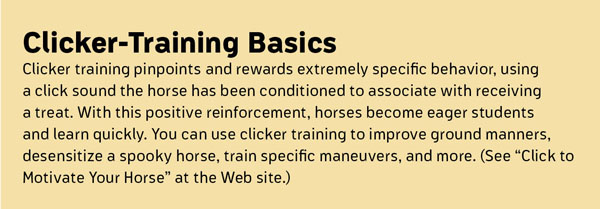Q Lately my 13-year-old National Show Horse gelding starts to lie down when I put him in crossties and attempt to saddle him. I’m worried he’ll hurt himself or my saddle. He’s used to being ridden, and he doesn’t try to lie down as I saddle him tied in the round pen—though he does pull away. Where might this sudden cinchiness come from, and how can I correct it?

DANIELLE STANDAGE, Arizona
A The sudden onset of your horse’s reaction could mean it’s a medical problem. Have your veterinarian thoroughly check your gelding for a physical issue. A sore back or withers can definitely cause cinchiness.
One method of checking for pain is administering an oral dose of phenylbutazone about an hour before trying to saddle him. If he then allows himself to be tacked up with a painkiller in place, that indicates his behavior may be caused by pain. On the other hand, if the collapsing behavior has become habitual, he may do it anyway, so also try saddling him in a new setting outside (not the round pen where he pulls back).
An ill-fitting saddle can cause pain. If need be, find a professional saddle fitter to assess your saddle on your horse, or try different saddles and see if it affects the behavior.
If pain isn’t the cause, your gelding may simply not want to be ridden and is lying down as an avoidance behavior. The recent onset makes me question what’s different in his riding routine. Is there a new rider involved, longer working sessions, new expectations, new stresses, new fears? Examine your routine with him. He may be anxious about being saddled because he’s anxious about being ridden, which he knows will follow.

Another approach to try is positive reinforcement. Many horses object to being saddled (though their evasions are more often turning and biting, or pulling back, rather than collapsing). With some reward-based training, you may convince your gelding that being saddled is a positive thing.
Try offering a piece of carrot for every notch you tighten the cinch. Start with the cinch quite loose, tightening it only gradually. Clicker training (see box) can work especially well here. First, put only the saddle pad on, then immediately click and give a treat. Do that 10 times. Then put the pad on and gently place the saddle on, clicking just as it settles onto his back, then give a treat. Do that 10 times. Next, gently put the pad and the saddle on, pass the cinch under him, and click as you draw the cinch up against him (then give a treat). Do that 10 times. With each notch of tightening, follow the same pattern.
Do this training over a period of about four days, with just the saddle pad the first day, then the saddle on the pad the next day, and so forth. Over a week’s time, you’ll know whether it’s working or not. If it is (and you’ve ruled out physical causes with a vet exam and saddle checking), you may not have to do anything else.
KATHERINE HOUPT
Professor Emeritus
Cornell University







